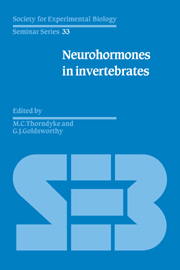Book contents
- Frontmatter
- Contents
- List of contributors
- Preface
- What is special about peptides as neuronal messengers?
- Part I Immunocytochemistry and Ultrastructure
- Part II Arthropod Neurohormones
- Part III Neurohormones in Coelenterates, Annelids and Protochordates
- Structure, location and possible actions of Arg–Phe–amide peptides in coelenterates
- Neuropeptides and monoamines in annelids
- Functional aspects of peptide neurohormones in protochordates
- Part IV Neurohormones in Molluscs
- Index
Functional aspects of peptide neurohormones in protochordates
Published online by Cambridge University Press: 04 August 2010
- Frontmatter
- Contents
- List of contributors
- Preface
- What is special about peptides as neuronal messengers?
- Part I Immunocytochemistry and Ultrastructure
- Part II Arthropod Neurohormones
- Part III Neurohormones in Coelenterates, Annelids and Protochordates
- Structure, location and possible actions of Arg–Phe–amide peptides in coelenterates
- Neuropeptides and monoamines in annelids
- Functional aspects of peptide neurohormones in protochordates
- Part IV Neurohormones in Molluscs
- Index
Summary
Introduction
The collective title protochordates is essentially a convenient ‘umbrella’ term for a diverse assembly of animals sharing relatively few, although important, common features. The protochordate group is usually thought to comprise three subphyla, the hemichordata, urochordata (tunicata) and cephalochordata, although some authorities consider the hemichordates a separate phylum. There are, however, no published reports on the occurrence of peptides or amines in hemichordates and they will not be considered further here.
The tunicates and cephalochordates are highly specialized marine organisms whose close relationship is perhaps rather superficial and, in reality, based more upon similar, ciliary powered, particle feeding mechanisms which have developed around the possession of a perforated pharynx, rather than any genuine and common phylogenetic background. Notwithstanding such reservations the protochordates are probably the only available extant representatives of ancient groups which “bridged the gap” between invertebrates and vertebrates, and as such could provide useful clues to the origins of certain vertebrate features.
The features which have attracted most attention and which have provided the most useful information are the central nervous system (CNS) and the gastrointestinal tract. The tunicate CNS has a relatively simple organisation which is in many respects rather more comparable with simple invertebrate neurosecretory centres than any part of the vertebrate CNS. Similarly the cephalochordate CNS is a simple anterior elaboration of the dorsal nerve cord (characteristic of these animals), and its structure and function reflects the highly specialized nature of the adult organism as well as its unusual and asymmetric development.
- Type
- Chapter
- Information
- Neurohormones in Invertebrates , pp. 235 - 258Publisher: Cambridge University PressPrint publication year: 1988
- 10
- Cited by



